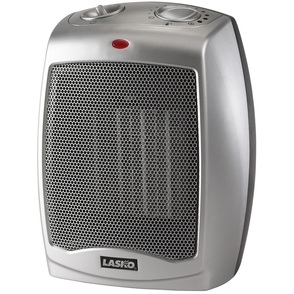Infrared Heaters Review
|
We Review Boys have years of history with infrared heaters and, as they continue to grow in popularity yet remain expensive compared to other heaters, we thought we'd review the basics of what infrared heaters are, what additional value they might offer, what to watch out for, and what heaters to consider before you make the investment. So here goes:
What is an Infrared Heater? Remember the electromagnetic spectrum from science class? Of course you do! That spectrum of wavelengths impacts us in a lot of ways. It allows us to use radios, microwaves, and x-rays ... all of which are waves we don't normally perceive as humans unless we're unfortunately exposed to a whole lot of them. There is also a narrow band of this spectrum that we perceive as visible light (colors). Just beyond our perception of the color red is the "infrared" spectrum. We perceive this as HEAT. The waves closest to the color we perceive are known as NEAR infared, and those further away are known as FAR infrared. However, you will feel any of this infrared as heat. |
There's nothing exceptional about producing infrared heat. You can do so with a heat lamp from a hardware store or many stores online, including Amazon. However, to create a portable heater with them, you'd need to:
1) Have enough bulbs to create adequate heat. This might take 5 or 6 x 250 watt bulbs. (This can also be done with PTC heating elements, which we'll discuss below.)
2) Enclose them for safety purposes.
3) Add a fan to move the heat effectively. (Radiant heaters are less expensive and a fine option for heating just one spot, but not a room.) Also a filter to maintain heater efficiency.
4) Include other features you might like to have, such as remote controls, timers, safety switches, etc.
Put all of that together with a nice looking exterior and you basically have an infrared heater. So now that we're clear about what an infrared heater is, let's take a look at what value they might offer beyond traditional space heaters ... and what they don't offer.
 This Lasko heater is highly reviewed
This Lasko heater is highly reviewedand only sets you back about $25 on Amazon.
It's their #1 selling space heater. Click to see it.
The Value of Infrared Heaters vs. Other Space Heaters
EdenPURE is really the brand that brought infrared heaters into popularity in the early 2000s, and it did so with effective infomercial campaigns. These compared their heaters to other space heaters and clearly showed -- using an infrared camera to demonstrate heat distribution in a room -- how quickly and evenly their infrared heater warmed a room compared to the competition. They also talked about how dangerous other space heaters were.
Unfortunately, they didn't make it clear that they were comparing an old wire heater that had no built in fan and that, yes, was a dangerous design that distributed heat poorly.
However, in my early days of testing infrared heaters, I literally tested an EdenPURE heater against another infrared heater and a traditional space heater. I tested with an infrared camera and a clock (to see how long it took to raise a closed room from one temperature to another) and a thermometer to see what heated the far corner to the upper temperature most quickly.
In other words, I was pretty thorough about it. And you know what I found?
All the heaters performed about the same and, if anything, the basic space heater warmed the room more quickly.
Another claim about the infrared heater is that it's supposed to not "burn the air" -- well the only type of heater I can think of that would do this is perhaps an oil heater. Still, I decided that maybe this meant it would retain more of the room's humidity. But no such thing. I measured that along with everything else, and all the heaters retained about the same humidity levels.
In short ... none of EdenPURE's claims seemed to live up to my testing, making it clear to me that they had really just benchmarked themselves against old, unsafe heaters. Now I'm happy to have them document their own tests against modern heaters, but this is what my tests showed, and I thought you'd like to know before spending money on an infrared heater.
EdenPURE is really the brand that brought infrared heaters into popularity in the early 2000s, and it did so with effective infomercial campaigns. These compared their heaters to other space heaters and clearly showed -- using an infrared camera to demonstrate heat distribution in a room -- how quickly and evenly their infrared heater warmed a room compared to the competition. They also talked about how dangerous other space heaters were.
Unfortunately, they didn't make it clear that they were comparing an old wire heater that had no built in fan and that, yes, was a dangerous design that distributed heat poorly.
However, in my early days of testing infrared heaters, I literally tested an EdenPURE heater against another infrared heater and a traditional space heater. I tested with an infrared camera and a clock (to see how long it took to raise a closed room from one temperature to another) and a thermometer to see what heated the far corner to the upper temperature most quickly.
In other words, I was pretty thorough about it. And you know what I found?
All the heaters performed about the same and, if anything, the basic space heater warmed the room more quickly.
Another claim about the infrared heater is that it's supposed to not "burn the air" -- well the only type of heater I can think of that would do this is perhaps an oil heater. Still, I decided that maybe this meant it would retain more of the room's humidity. But no such thing. I measured that along with everything else, and all the heaters retained about the same humidity levels.
In short ... none of EdenPURE's claims seemed to live up to my testing, making it clear to me that they had really just benchmarked themselves against old, unsafe heaters. Now I'm happy to have them document their own tests against modern heaters, but this is what my tests showed, and I thought you'd like to know before spending money on an infrared heater.

However ... there ARE some Potential Benefits
Despite what my testing showed, I still like infrared heaters for a few potential benefits. First, there is a lot of research into the health benefits of infrared rays. There are debates about whether NEAR or FAR infrared rays are better for you. I lean toward the camp of NEAR infrared rays being healthier, and I believe heaters may generally produce FAR infrared; but I think both can be useful.
Having said that, infrared rays generally shouldn't penetrate directly through a heater enclosure. Instead, the heat you enjoy should be from air that's been warmed inside the heater. Despite this, some people (without any financial bias) make remarkable claims about how sitting near an infrared heater improves their joints. So there MAY be health benefits to using infrared heaters rather than traditional space heaters, at least for some people.
Second, some infrared heaters -- like EdenPURE's -- have a wide mouth design that I love. Why? First, it's quieter than small heaters, which have to push air through a smaller opening. Second, with the wide mouth, you get a wider and wonderfully warm breeze rather than a hot stream of air from a small mouth. As someone who typically struggles to stay warm, I find this much more enjoyable when sitting in the line of fire, so to speak.
Finally, infrared heaters often have features that inexpensive space heaters don't have. Air filters, remote controls, timers. So this partly explains the increased cost over other heaters. Even ceramic heaters that have these features approach the cost of many infrared heaters. (Though this #1 seller on Amazon -- not infrared -- is under $50 with plenty of features.)
On the topic of cost ... EdenPURE is still by far the most expensive, and I don't know that they bring any additional benefits. In fact, they suffer from a lot of bad reviews in part because their heaters break down and in part because of poor customer service. Despite their name, I would personally recommend a less expensive infrared heater. But before recommendations, let's look at a couple heater details you should know:
Despite what my testing showed, I still like infrared heaters for a few potential benefits. First, there is a lot of research into the health benefits of infrared rays. There are debates about whether NEAR or FAR infrared rays are better for you. I lean toward the camp of NEAR infrared rays being healthier, and I believe heaters may generally produce FAR infrared; but I think both can be useful.
Having said that, infrared rays generally shouldn't penetrate directly through a heater enclosure. Instead, the heat you enjoy should be from air that's been warmed inside the heater. Despite this, some people (without any financial bias) make remarkable claims about how sitting near an infrared heater improves their joints. So there MAY be health benefits to using infrared heaters rather than traditional space heaters, at least for some people.
Second, some infrared heaters -- like EdenPURE's -- have a wide mouth design that I love. Why? First, it's quieter than small heaters, which have to push air through a smaller opening. Second, with the wide mouth, you get a wider and wonderfully warm breeze rather than a hot stream of air from a small mouth. As someone who typically struggles to stay warm, I find this much more enjoyable when sitting in the line of fire, so to speak.
Finally, infrared heaters often have features that inexpensive space heaters don't have. Air filters, remote controls, timers. So this partly explains the increased cost over other heaters. Even ceramic heaters that have these features approach the cost of many infrared heaters. (Though this #1 seller on Amazon -- not infrared -- is under $50 with plenty of features.)
On the topic of cost ... EdenPURE is still by far the most expensive, and I don't know that they bring any additional benefits. In fact, they suffer from a lot of bad reviews in part because their heaters break down and in part because of poor customer service. Despite their name, I would personally recommend a less expensive infrared heater. But before recommendations, let's look at a couple heater details you should know:
- PTC vs. Quartz Elements. These are the two technologies used to produce infrared heat. Quartz bulbs were the original technology, but they have a much shorter life span than PTC, so I recommend looking for heaters that include PTC heating elements.
- Wattage Settings. Most heaters have a high setting of 1500 watts and a low setting option that may be 750 or 1000 watts. The higher the wattage, the larger an area you can potentially heat, but the more you'll spend on energy. So if you're primarily sitting near your heater, you can get away with less wattage. But if you're warming a decent sized room, make sure to avoid low watt heaters.
- Realistic Coverage. Don't be misled by fancy ads. All 1500 watt heaters will warm about the same size area, and it will be difficult to warm 1000 square feet with any size heater. However, low ceilings, closed doors, and good insulation are the types of factors that will help a heater cover more area. These are supplemental heaters designed to help you lower your overall house temperature while keeping the most used areas comfortable.
- Realistic Savings. Used correctly (see "Realistic Coverage"), these heaters can save you money. Your savings will vary based on how well you lower your house temperature and focus on heating a zone with the heater. Savings will increase if you normally heat your home with expensive fuels like oil or propane.
Recommended Heaters
At this time we recommend the following heaters because of the features or overall user experiences or brands that back them up. All of these heaters max out at 1500 watts, so should provide about the same heating capacity.
|
Dr. Infrared Heater
|
|
|
pureHeat Infrared Heater & Air Purifier
|
|
|
Lasko Infrared Heater
|
|
|
Cost-Saving Alternative: Radiant Heater
Here's an alternative worth knowing about. If you just need to warm yourself in one location -- like at a desk you use much of the day -- a radiant heater like this is inexpensive to buy and operate. The low setting is 300 watts and the high setting is 600 watts. There is no fan, and it has a tip-over shutoff function. Nothing fancy, but it will keep you extremely warm in that one spot. (I only use the 300 watt setting myself.) It will not, however, do a lot to warm up a room. That's not its purpose. |
|
Review Boys is Copyright © 2013-2024 Avalon Partners, LLC.
Disclosure: Review Boys are never paid for their reviews, though they may have received free samples for review.
Review Boys may include affiliate links to products.


